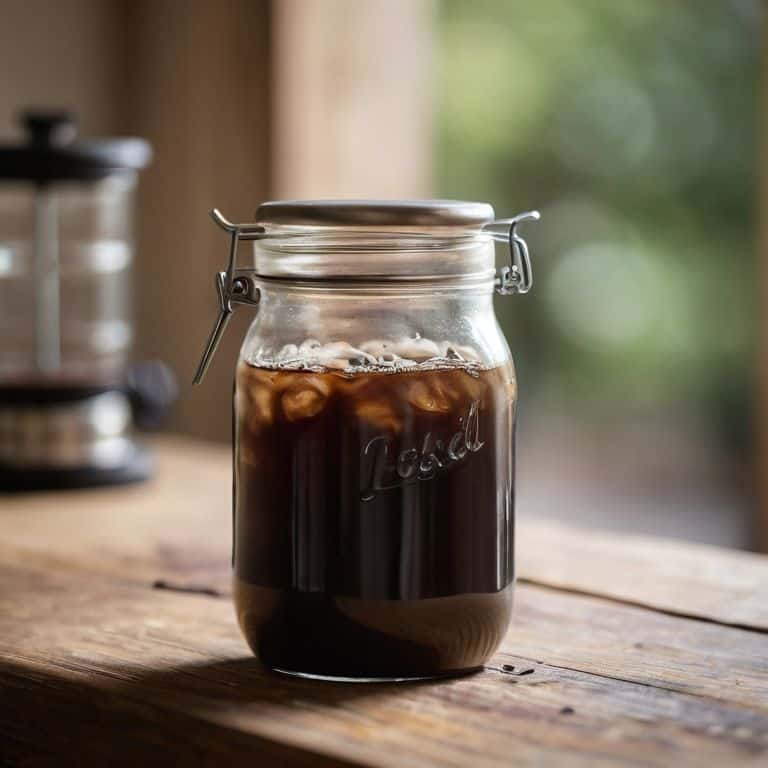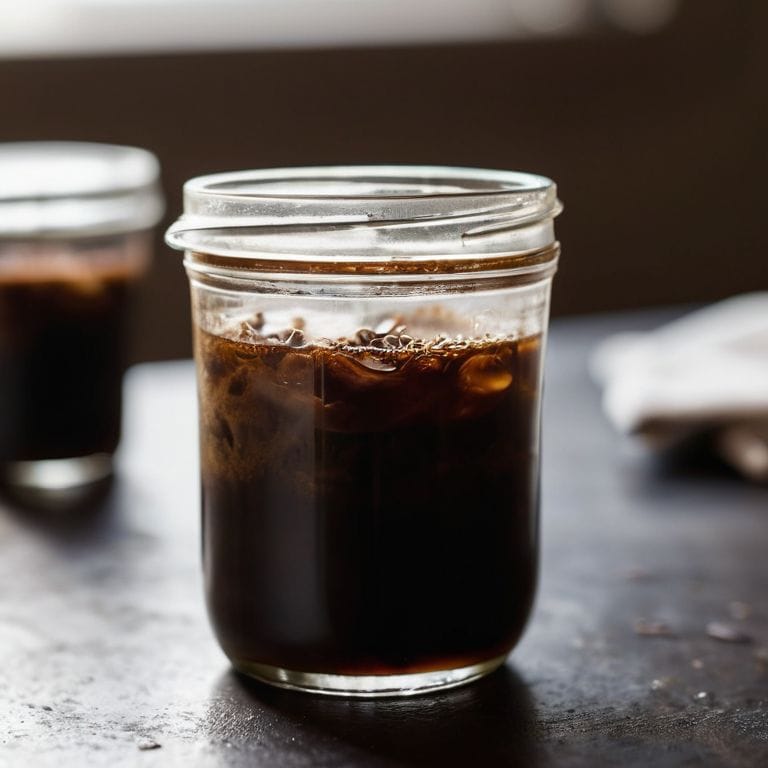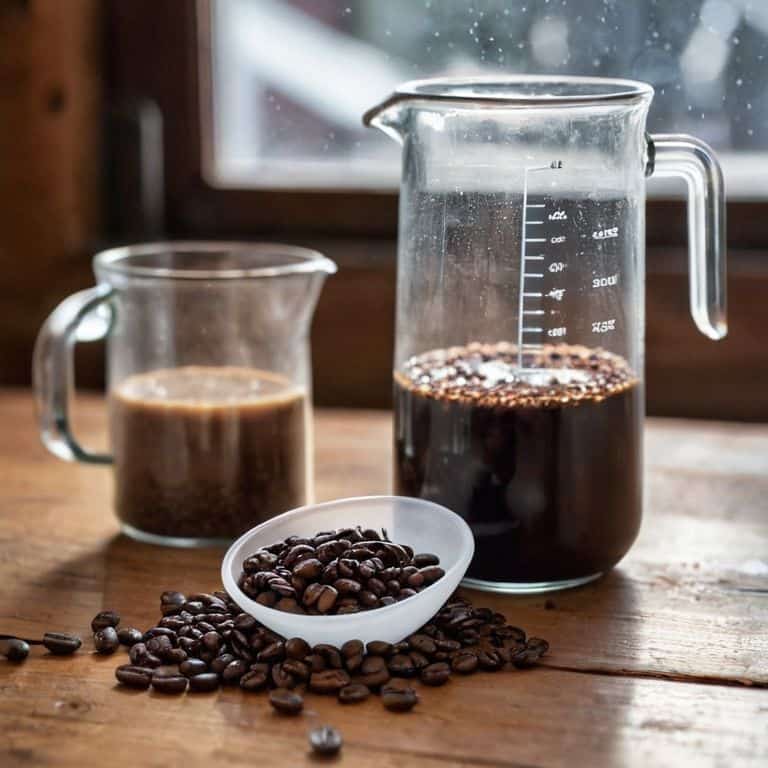I still remember the day I discovered the best coffee to water ratio for cold brew – it was like a revelation in a cup. For years, I’d been experimenting with different ratios, only to be met with subpar results. The common myth that a 1:3 ratio is the magic number had me frustrated, to say the least. But, after countless trials and tastings, I found that the sweet spot lies elsewhere. It’s amazing how a simple adjustment can elevate the entire brewing process, making it a truly meditative experience.
As a certified Q Grader and National Barista Champion, I’m excited to share my findings with you. In this article, I’ll cut through the noise and provide you with practical advice on how to achieve the perfect cold brew. You’ll learn how to balance your coffee and water, and what ratio works best for your taste preferences. I’ll also dive into the science behind extraction, so you can understand the ‘why’ behind every step. By the end of this guide, you’ll be well on your way to brewing cafe-quality cold brew at home, and maybe even discovering your own best coffee to water ratio for cold brew.
Table of Contents
Guide Overview: What You'll Need

Total Time: 12 hours to 24 hours
Estimated Cost: $10 – $30
Difficulty Level: Easy
Tools Required
- Large glass jar with a lid, at least 1 quart in size
- Fine-mesh strainer
- Measuring cups
- Measuring spoons
Supplies & Materials
- Coarse-ground coffee light or dark roast, your preference
- Cold water filtered, if possible
- Sugar or sweetener optional
- Milk or creamer optional
Step-by-Step Instructions
- 1. First, let’s start with the foundation of any great cold brew: selecting the right coffee beans. I always look for a single-origin, high-quality bean that’s been freshly roasted. For cold brew, I prefer a lighter roast to bring out the nuances in flavor. Take your time to choose the perfect bean, as it will make all the difference in the end result.
- 2. Next, we need to grind those beautiful beans. I’m extremely particular about my grind size, as it affects the extraction rate of the brew. You’re aiming for a medium to coarse grind, similar to kosher salt. If you’re using a burr grinder, take note of the settings and adjust accordingly. I find that a consistent grind is crucial for a balanced flavor.
- 3. Now it’s time to measure out our coffee and water. I always use a 1:4 ratio of coffee to water, which I’ve found to be the sweet spot for cold brew. So, if you’re using 1 cup of coffee, you’ll want 4 cups of water. Make sure to use a scale to get an accurate measurement, as this will impact the final flavor of your brew.
- 4. In a large glass or stainless steel container, combine your measured coffee grounds and water. Stir the mixture gently to ensure all the grounds are saturated, then cover the container with a lid or plastic wrap. I like to use a glass container, as it allows me to see the coffee bloom and ensures no unwanted flavors are imparted into the brew.
- 5. Let the mixture steep in the refrigerator for at least 12 hours, but no more than 24 hours. The longer it steeps, the stronger the brew will be. I find that 18 hours is the perfect amount of time to bring out the full flavor potential of the coffee. Be patient, as this step is crucial for developing the complex flavors you’re looking for.
- 6. After the steeping process, it’s time to strain the mixture. I use a fine-mesh sieve or a coffee filter to separate the grounds from the liquid. Be careful not to squeeze the grounds, as this can introduce bitter flavors into your brew. Discard the grounds and reserve the liquid.
- 7. Finally, transfer your cold brew to a glass bottle and store it in the refrigerator. I like to use a glass bottle with a tight-fitting lid to preserve the flavors and aromas. Your cold brew is now ready to drink, and you can enjoy it over ice or use it as a base for your favorite coffee drinks. Remember to experiment and adjust the ratio and steeping time to your liking, as the perfect cold brew is a personal preference.
Cold Brews Golden Ratio

As I delve deeper into the world of cold brew, I’ve come to realize that the golden ratio of coffee to water is just the beginning. The optimal cold brew steeping time, for instance, can greatly impact the flavor profile of the final product. I’ve found that a steeping time of around 18-24 hours yields a smooth and full-bodied flavor, perfect for those who enjoy a strong cold brew coffee concentrate.
When it comes to serving, the cold brew coffee to milk ratio is also crucial. I personally prefer a ratio of 1:3, as it allows the rich flavors of the coffee to shine through while still providing a creamy texture. Of course, this ratio can be adjusted to suit individual tastes, but it’s a great starting point for those looking to experiment.
In my experience, using high-quality coffee beans specifically suited for cold brew can make all the difference. I’ve had great success with Ethiopian and Colombian beans, which provide a fruity and floral flavor profile that complements the cold brew method perfectly. By combining these beans with the right ratio and steeping time, you’ll be well on your way to creating a truly exceptional cold brew coffee experience.
Best Coffee Beans for Cold Brew Perfection
When it comes to cold brew perfection, the type of coffee bean is just as crucial as the ratio. I swear by single-origin beans, particularly those with notes of chocolate and caramel. The nuanced flavors they bring to the table are a game-changer. For my cold brew, I’m obsessed with Ethiopian Yirgacheffe – its delicate floral hints add a mesmerizing depth. Experimenting with different roasts is also essential; I find that a medium to light roast allows the coffee’s natural acidity to shine through, creating a beautifully balanced brew.
Unlocking Optimal Steeping Times
Unlocking Optimal Steeping Times
As I dive deeper into the world of cold brew, I’ve found that steeping time is just as crucial as the golden ratio. For me, the sweet spot is between 18-24 hours – any less, and the flavors are underdeveloped; any more, and the brew becomes over-extracted and bitter. I’ve experimented with steeping times ranging from 12 to 48 hours, and the difference is astounding.
Within this 18-24 hour window, I’ve discovered that the ideal steeping time depends on the specific coffee beans and roast level. Generally, lighter roasts require a shorter steeping time, while darker roasts can handle a longer steep. By fine-tuning the steeping time, you can coax out the unique characteristics of your coffee, resulting in a brew that’s both balanced and full of flavor.
The Artisan's Touch: 5 Essential Tips for Mastering the Best Coffee to Water Ratio for Cold Brew
- Start with a foundation of 1:4, but don’t be afraid to experiment and adjust the ratio to suit your taste preferences – I’ve found that a slightly stronger ratio of 1:3.5 brings out the nuances in my favorite Ethiopian Yirgacheffe
- Use a digital scale to measure your coffee and water with precision – I aim for an accuracy of 0.1 grams to ensure consistency in every batch
- Choose a water with a balanced mineral profile, as this will significantly impact the flavor of your cold brew – I swear by using a water with a TDS of around 150-200 ppm for optimal extraction
- Grind size matters, even for cold brew – aim for a medium-coarse grind that allows for the perfect balance of extraction and body, and be prepared to adjust based on the specific coffee beans you’re using
- Temperature control is crucial, even when brewing cold – I recommend using chilled water at a temperature between 40-45°F to slow down the extraction process and prevent over-extraction, resulting in a smoother, more full-bodied cold brew
Key Takeaways for the Perfect Cold Brew
I’ve found that mastering the 1:4 coffee to water ratio is crucial for a balanced cold brew, but don’t be afraid to experiment and adjust to your taste
Unlocking the optimal steeping time is an art that requires patience – I recommend aiming for a sweet spot between 16 to 20 hours to bring out the full flavor potential of your coffee beans
Choosing the right coffee beans can make or break your cold brew; look for high-quality, freshly roasted beans with unique flavor profiles to elevate your cold brew game and discover your perfect cup
The Harmonious Balance
The best coffee to water ratio for cold brew isn’t just a measurement, it’s a symphony of flavors – and when you find that perfect harmony, every sip is a revelation.
Julian Vale
The Perfect Brew Awaits

As we conclude our journey to uncover the best coffee to water ratio for cold brew, it’s essential to remember that the perfect balance is not just about numbers, but about harmony. We’ve explored the optimal steeping times, the finest coffee beans for the task, and the _golden ratio_ that brings it all together. By mastering these elements, you’ll be well on your way to creating cold brews that are nothing short of exceptional. Whether you’re a seasoned barista or a home enthusiast, the key to success lies in _precision_ and a willingness to experiment until you find your perfect cup.
So, as you embark on your own cold brew adventures, remember that the pursuit of the perfect shot is a journey, not a destination. It’s about the _joy of discovery_, the satisfaction of crafting something with your own hands, and the delight of sharing that with others. With every brew, you’re not just making a drink – you’re creating an experience. And with the right ratio, the right beans, and a bit of patience, you’ll be unlocking a world of flavors that will leave you and your loved ones in awe of the simple, yet extraordinary, beauty of a well-crafted cup of coffee.
Frequently Asked Questions
What happens if I use a darker roast coffee, will the optimal water ratio change?
Darker roasts can be a game-changer for cold brew, but they do require a slight adjustment. I find that a 1:4.5 ratio works beautifully, as the bolder flavors can handle a bit more water without getting lost. Experiment with small tweaks to find your perfect balance – it’s all about nuance when working with those rich, dark notes.
Can I adjust the coffee to water ratio to suit my personal taste preferences without affecting the overall quality of the cold brew?
Absolutely, adjust away! I encourage experimentation to find your perfect balance. If you prefer a stronger brew, try a 1:3 ratio, or for a lighter taste, 1:5 works beautifully. Remember, it’s all about harmony, so tweak that ratio to suit your senses, and don’t be afraid to dial it in to your taste buds’ delight.
How does the grind size of the coffee beans impact the ideal water ratio for cold brew, and are there any specific grind size recommendations?
For me, grind size is crucial – it’s all about surface area. A medium to coarse grind, around 1.2-1.5 mm, allows for the perfect balance of extraction and body. If your grind is too fine, you’ll end up with over-extracted, bitter coffee, while too coarse can result in under-extracted, weak brew. I swear by this sweet spot for optimal cold brew flavor.



